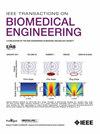超声波流动成像的计算高效 SVD 滤波及超快多普勒的实时应用
IF 4.4
2区 医学
Q2 ENGINEERING, BIOMEDICAL
引用次数: 0
摘要
在过去的十年中,超声微血管成像出现了高灵敏度技术,如超快功率多普勒(UPD)和超声定位显微镜(ULM)。这些技术的基石是在非聚焦波传输的基础上获取大量帧,从而能够使用奇异值分解(SVD)作为强大的杂波滤波器,将微血管与周围组织分离开来。遗憾的是,SVD 的计算成本很高,阻碍了它在实时 UPD 成像中的应用,并拖累了 ULM 处理链,对临床影响显而易见。为了解决这个问题,我们提出了一种实现 SVD 滤波的新方法,这种方法基于简化的基本操作,可以在 GPU 上实现最佳并行化(GPU sSVD),这与主要采用串行方式的标准 SVD 算法不同。首先,我们展示了 GPU sSVD 对 UPD 和 ULM 数据的过滤效果,与标准 SVD 实现相比,计算效率很高,而且不会降低图像质量。其次,我们证明了所提出的方法适用于实时操作。GPU sSVD 与空间相似性矩阵(SSM)一起被嵌入到一台研究型扫描仪中,SSM 是一种众所周知的自动选择 SVD 血液成分的高效方法。在使用大量帧包时,无论是否使用空间相似矩阵,GPU sSVD 的高实时吞吐量都得到了验证。例如,在 128 × 64 样本波束成形网格上使用 512 个数据包过滤了超过 15000 帧/秒的数据。最后,GPU sSVD 首次用于对健康志愿者进行实时自适应 SVD 滤波的 UPD 成像。本文章由计算机程序翻译,如有差异,请以英文原文为准。
Computationally Efficient SVD Filtering for Ultrasound Flow Imaging and Real-Time Application to Ultrafast Doppler
Over the past decade, ultrasound microvasculature imaging has seen the rise of highly sensitive techniques, such as ultrafast power Doppler (UPD) and ultrasound localization microscopy (ULM). The cornerstone of these techniques is the acquisition of a large number of frames based on unfocused wave transmission, enabling the use of singular value decomposition (SVD) as a powerful clutter filter to separate microvessels from surrounding tissue. Unfortunately, SVD is computationally expensive, hampering its use in real-time UPD imaging and weighing down the ULM processing chain, with evident impact in a clinical context. To solve this problem, we propose a new approach to implement SVD filtering, based on simplified and elementary operations that can be optimally parallelized on GPU (GPU sSVD), unlike standard SVD algorithms that are mainly serial. First, we show that GPU sSVD filters UPD and ULM data with high computational efficiency compared to standard SVD implementations, and without losing image quality. Second, we demonstrate that the proposed method is suitable for real-time operation. GPU sSVD was embedded in a research scanner, along with the spatial similarity matrix (SSM), a well-known efficient approach to automate the selection of SVD blood components. High real-time throughput of GPU sSVD is demonstrated when using large packets of frames, with and without SSM. For example, more than 15000 frames/s were filtered with 512 packet size on a 128 × 64 samples beamforming grid. Finally, GPU sSVD was used to perform, for the first time, UPD imaging with real-time and adaptive SVD filtering on healthy volunteers.
求助全文
通过发布文献求助,成功后即可免费获取论文全文。
去求助
来源期刊

IEEE Transactions on Biomedical Engineering
工程技术-工程:生物医学
CiteScore
9.40
自引率
4.30%
发文量
880
审稿时长
2.5 months
期刊介绍:
IEEE Transactions on Biomedical Engineering contains basic and applied papers dealing with biomedical engineering. Papers range from engineering development in methods and techniques with biomedical applications to experimental and clinical investigations with engineering contributions.
 求助内容:
求助内容: 应助结果提醒方式:
应助结果提醒方式:


